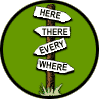You decide to scout for a potential colony world. So far, all of humanity is just in one solar system. If human beings want to be taken seriously in the galaxy, we should probably have a few more planets. "Erin, do you have a list of the best candidates for a human colony?" you ask your AI.
"I do, I'm putting four worlds on your display now." She tells you, and four globes appear on your view screen.
"The closest is Alpha Centauri Bd." She tells you as one of the gloves becomes highlighted. "Obviously you know about Alpha Centauri. It's the closest solar system to Earth, only 4 light years away. It's not taken because, well, it's in your neighborhood. No other race has really visited your neck of the woods aside from the Erimosi. And they just got here a few years ago. Alpha Centauri is a three star system, and Bd is the third planet around the second brightest star. Got that?" She asks, perhaps a tad condescendingly. You nod and gesture for her to continue. You assume she can see you as well as respond to voice commands, and she proceeds.
"Bd is very Earth-like. The planet is 0.87 Earth masses, and 60% water, 40% terrestrial. Temperature is approximately Earth normal. The star it orbits is an orange dwarf, slightly dimmer and cooler than Earth's sun. But Bd makes up for it by being a lot closer. It should be the ideal place for a human colony. However, due to its three suns, there are rarely any times of night or dark. Because of the constant sunlight, there is very dense vegetation. And the lack of night may have long term psychological effects on humans.
"Option two is Tau Ceti e!" Erin continues enthusiastically, highlighting the second orb. "This one is 11.9 light years away, orbiting a very Sun-like star. This is the fourth planet in the Tau Ceti system. It's 4.3 Earth Masses, which actually isn't that big compared to many planets, Earth is actually on the small side of normal. Don't worry, the gravity is only a tiny bit higher than Earth sea level. You probably won't even notice it after a minute. The downside to Tau Ceti e: it's really hot. The average temperature is about 100 degrees Fahrenheit above Earth normal. This world is full of jungles and steamy oceans. But the poles would be comfortable for humans, and worth exploring. The south pole of Tau Ceti e averages around 80 F in the summer, and sometimes even snows in the winter! Thankfully, there are continents located at each pole." Erin tells you. While a swelteringly hot world might not be pleasant, at least part of it might be a good fit for a colony. It wouldn't be so bad to have a settlement at each pole. And some people who can stand the heat might move a tiny bit farther in.
"Option three: Kapteyn b. Kapteyn is a very old red dwarf system. So old that's its actually kind of surprising that intelligent life hasn't developed here yet. This is the closest planet to its small star, and its 4.8 Earth masses. The planet only gets a small amount of red-shifted light from the star, resulting in dark purple and black colored plant life. The mid-day sun on Kapteyn b would only look like dusk on Earth, and there's no moon for any moonlight. But other than that, it looks like a world that would be suitable to humans. Temperature readings appear within human normal, and there's no obvious toxins in the atmosphere. There actually isn't too much information on this world. The Erimosi probe sent here a century ago malfunctioned once it landed. But that means you'll get to figure it out on your own!" Erin tells you optimistically.
"Last but not least: Gliese 581 d. This is one of the first habitable exoplanets humans discovered on their own! It orbits a red dwarf 20 light years away, and it's a pretty big 7 Earth masses. It's on the cold end of habitable, but still has liquid water. Picture a big Earth experiencing a very major ice age. Gravity is about double Earth standard but… you're in good shape, right?" Erin asks you innocently. The cold and double gravity make this world sound the least appealing. You certainly don't relish the thought of weighing twice as much. It's also the farthest away. Then again, maybe it'd be good to claim this one for humanity before some other species decides to take it.
You mull over your options. Alpha Centauri Bd is the obvious first choice, but in a way that makes it almost boring. Besides, having no night sounds a little weird. Tau Ceti e sounds unpleasant, but then again it wouldn't be so bad if humans only live on parts of it. That's still plenty for a colony. Kapteyn b, despite being dim to dark all the time, also seems like a good choice, and you find the prospect of learning things the Erimosi don't even know pretty intriguing. And then there's Glises 581 d... cold and heavy. It'd be an adventure, at least. Deciding, you tell Erin to set course to:
